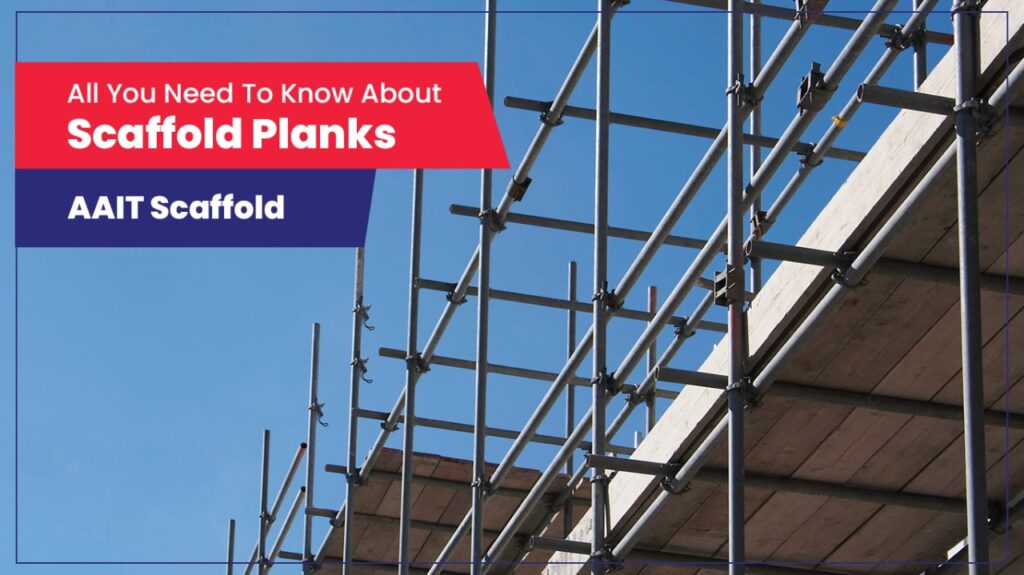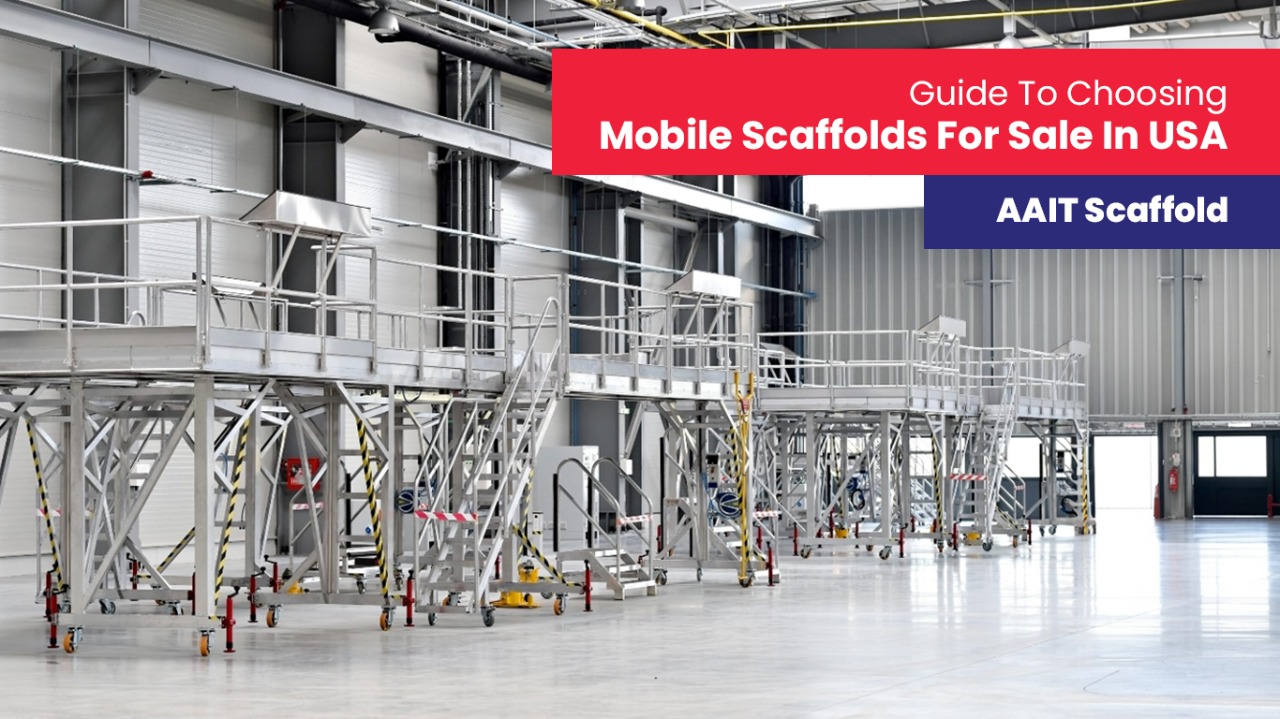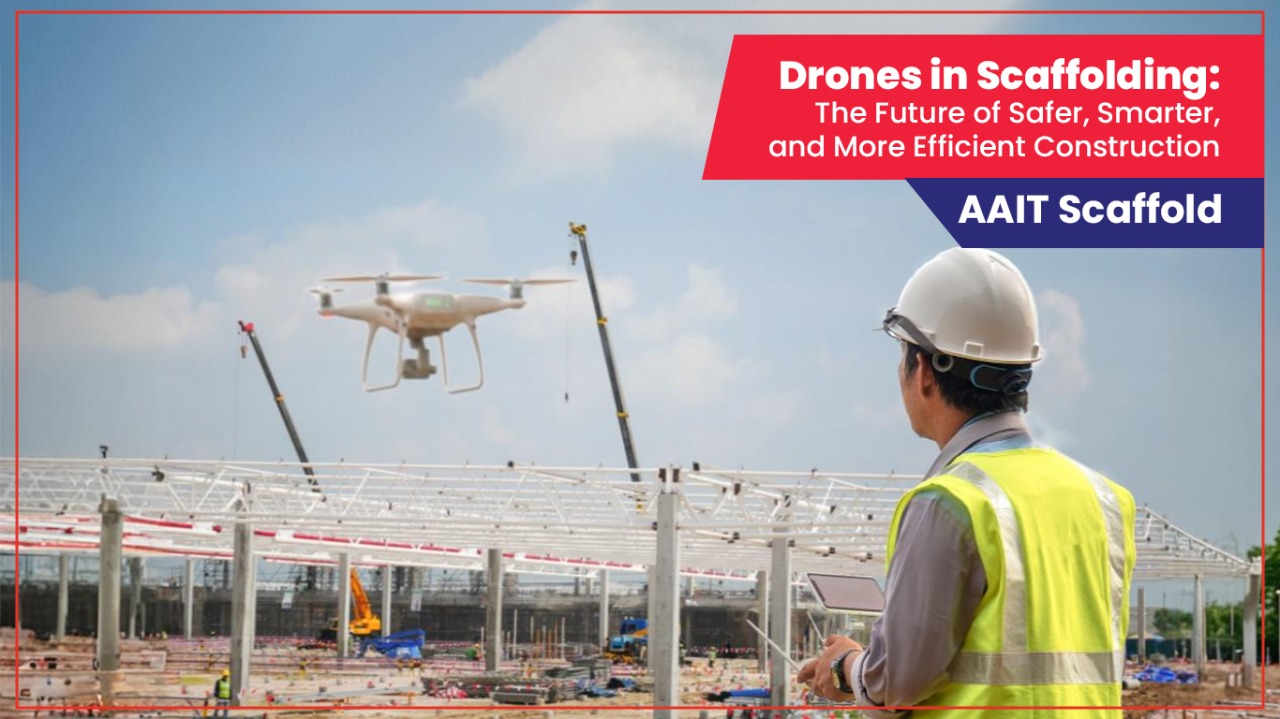All You Need to Know About Scaffold Planks
Comments Off on All You Need to Know About Scaffold PlanksAre you planning a construction project or just curious about how workers stay safe up high? Scaffold planks are more important than you might think. They not only support weight but also offer safety and efficiency. This blog will walk you through everything worth knowing about scaffold planks. Ready to get started?
1. What is Scaffold Planks?
Have you ever considered how individuals get to those high spots safely, whether during a construction job or for repairs? That’s where scaffold planks come in! Scaffold planks provide robust and stable platforms or pathways for workers to navigate at heights. Scaffold planks are used around different scaffolding systems like ringlock, cuplock, kwikstage, and mobile towers. Made from tough materials like aluminum, steel, or wood, these planks are specially designed to keep workers safe and steady while they get the job done.
2. Types of Scaffold Planks
When choosing scaffold planks, you have numerous options to consider depending on the specific needs of your project.
Wood
Classic wooden scaffold planks are typically crafted from robust woods such as fir or pine. They feel comfortable underfoot and are easy to install and remove. You will usually see them in traditional bamboo and wooden scaffolding or heavy-duty ramps. To make them last longer, the ends are often reinforced with iron wire or sheets.
Steel
Do you need something tougher? Steel scaffold planks may be the way to go. They are made of robust steel, such as Q195 or Q235, and are ideal for heavy-duty operations. They are commonly seen on ringlock scaffolding, kwikstage systems, and scaffold towers, particularly in industries where fire safety is critical.
Aluminum
If you want something lightweight but robust, aluminum scaffolding boards are an excellent choice. They can be easily transported, have a long lifetime, and do not rust. There are various operations like inside decoration, exhibition hall upkeep, and high-rise building that require weight and call for aluminum planks.
Plastic
Plastic scaffold planks are the new kid on the block and are produced from recyclable materials. They are lightweight, durable, and super easy to clean, but they are not the best in extreme weather or with heavy impact objects. Even though they are eco-friendly, many still prefer sticking to the more familiar wood or steel boards.
3. Advantages and Disadvantages of Scaffold Planks
Wooden scaffold planks:
Advantages
1) The wooden planks are light in weight and are easy to carry.
2) The natural surface absorbs sounds and will help you to lower noise levels.
3) The textured surface helps stop slipping and offers a good grip.
4) More reasonably priced than other materials, they are.
5) Installation and removal call for no further tools; they are quick and easy.
Disadvantages
1) They require frequent maintenance to keep them safe and in good shape.
2) Even treated wood can absorb water, making it heavier and less stable.
3) Wood is combustible unless treated, which might weaken the plank.
4) They may shift and bounce slightly when walked on, particularly over time.
Steel Scaffold Planks:
Advantages
1) They have a high load-bearing capability and can accommodate large equipment and workers.
2) Steel is very resistant to moisture and extreme weather conditions.
3) These boards are fire-resistant and work well in high-temperature situations.
4) They require little maintenance and are easy to clean.
5) Steel planks are long-lasting, which minimizes the need for regular replacements.
Disadvantages
1) The initial cost is higher than with wood or other materials.
2) Steel planks are heavy, which makes them difficult to transport and install.
3) Their weight raises transportation expenses, particularly at larger sites.
4. Difference Between Steel Scaffold Planks And Wooden Scaffold Planks
| Aspect | Wooden Scaffold Planks | Steel Scaffold Planks |
| Cost | More cheap and suitable for short-term or small-scale initiatives. | Material and production complexity generally result in higher costs |
| Maintenance | Weather damage necessitates regular maintenance, treatments, and replacements. | Low maintenance and improved resilience to weather and corrosion. |
| Transport | Although lightweight and portable, it requires cautious handling to avoid moisture damage. | Heavier and more difficult to transport, but more stable and less likely to be damaged in transportation. |
| Lifetime | It wears easily, rots, and is susceptible to weather damage; thus, it does not endure as long. | Long-lasting and resilient, even in harsh site circumstances. |
| Load Bearing | Because of its lesser strength, it is better suited to light-duty applications and temporary settings. | Stronger and more stable, ideal for heavier loads and long-term projects. |
5. Maintenance and Storage
Maintaining the safety and lifetime of your scaffold plank means how they are taken care of. These ideas help you to properly preserve and store them:
1) Cleaning and preserving scaffold planks.
Cleaning scaffold boards on a regular basis will help to remove dirt and debris. Avoid using harsh chemicals or abrasive cleansers that can damage the wood, ensuring that it lasts longer when reused.
2) Treating with protective coatings.
For wood planks or hot-dip galvanized steel, consider protective coatings, including corrosion-resistant paint. Verify treatment options with the supplier when you are buying.
3) Ideal Scaffold Plank Storage
Store the planks under dry, safe, well-ventilated conditions. Protect wood from direct sunlight and dampness to prevent damage.
6. OSHA requirements for scaffolding planks
OSHA (Occupational Safety and Health Administration) was founded in 1970 and establishes safety rules to maintain safe working environments, including scaffolding.
OSHA requires wooden scaffold planks to follow accepted grading standards and be in good condition, free of cracks and coverings such as paint or concrete that could conceal deterioration. Usually, boards that say “OSHA Conformed” meet these standards.
The length and thickness of planks also matter. Longer boards bend more under weight (deflection), reducing load capacity. As a result, choosing planks of the correct size and strength is crucial. Regulations differ by region, so always check with local authorities or experts to verify compliance.
7. Scaffold Board Safety Tips
When using scaffold boards, it is crucial to adhere to a few simple but important safety requirements to keep everyone on the job safe.
Install properly.
Make sure all boards are tightly secured and accurately installed before usage. Planks that are loose or uneven could cause major mishaps.
Inspect often.
Before and after use, always check scaffolding boards. Look for cracks, splits, warping, and other damage markers. Should you find any issues, quickly replace the compromised board with a safer one.
Know the Weight Limits
Each scaffold board comes with a load capacity; make sure you stick to it. Overloading boards beyond their limits can cause them to weaken or break, which will put everyone at risk.
Distribute Weight Evenly
Never pile tools or supplies in one place. To prevent straying too much to one side of the board, make sure the weight is distributed equally.
Conclusion
Scaffold planks are required for safe operations at heights. Choosing the appropriate type, using them correctly, and performing regular maintenance all help to prevent accidents. Always observe safety guidelines and inspect your planks before use. So, before you begin your next project, take a moment to inspect your planks to ensure that they are safe, clean, and adequate for the work. If so, you’re now a step closer to working smarter and safer at height.
FAQ
1. Can I get scaffold planks in customized sizes?
Absolutely! If you require a specific length or width, please let us know. We are happy to tailor the planks to meet your exact specifications and ensure that they match your project correctly.
2. Are any scaffold planks made of pine wood?
Yes, some scaffold boards are constructed of pine wood, particularly for light or temporary operations. However, because pine is a softwood, it may not be as strong or durable as materials such as steel, aluminum, or composite boards, which are better suited for heavy-duty or long-term use.
3. What is the lifespan of a scaffold plank?
A lot of elements define this, which includes the composition, use, and upkeep of the board. If the board is well maintained and made of metal and other premium materials, it can last a great length of time. Their lifetime can be much increased by regular checks and proper storage.
4. Comparatively, are scaffold boards stronger than deck boards?
Not exactly, as they serve different purposes. Scaffold boards support workers and supplies at building sites. On the other hand, decking planks do the job in outdoor spaces like patios. While decking boards put look and comfort underfoot first, scaffold planks stress strength and stability.
Guide to Choosing Mobile Scaffolds for Sale in USA
Comments Off on Guide to Choosing Mobile Scaffolds for Sale in USAIf you are a contractor working on a busy commercial site or a homeowner tackling a big DIY project then mobile scaffolds can become a go-to solution for you for safe and flexible access to heights. Easy to move and providing a strong base, they are a popular choice in both residential and business sectors of the USA.
In this guide, we will walk you through everything you need to know, from understanding what makes mobile scaffolding unique to how you can choose the right one for your needs.
What Makes Mobile Scaffolding Different?
When it comes to traditional scaffolding, it is usually fixed in place. On the other hand, mobile scaffolding comes with wheels or casters at the base. This simple design tweak makes a world of difference. This will allow you to easily roll the scaffold around without having to dismantle or rebuild it every time you move locations.
This mobility does not mean you are compromising on strength or stability. Most mobile scaffolds are built from robust materials like aluminum and steel that offer trusted support for all kinds of tasks, including painting walls, fixing ceilings, or repairing roofs.
Prime Advantages of Mobile Scaffolds:
Still wondering why mobile scaffolds are gaining popularity? Here are some key reasons:
Time Saving: The wheels move the scaffold quickly between work areas.
Cost-Effective: It helps in reducing labor time and effort.
Flexible usage: It is suitable for both indoor and outdoor work.
Space Efficiency: It is easy to store and transport.
Improved Productivity: Work without interruptions as you shift the scaffold with ease
Why Do USA Builders and Homeowners Prefer Mobile Scaffolds?
Let’s face it, ladders have their limits. Builders and homeowners across the USA are turning to mobile scaffolding because it reduces the gap between basic ladders and full-scale scaffolding systems.
Mobile scaffolds give builders dependable platforms for long-term projects free from tipping over risk. When homeowners renovate, clean gutters, or simply replace the light fixtures in high-ceilinged rooms, they like the simplicity and extra security.
Plus, with improved safety features and American safety compliance, these scaffolds are a smart choice for anyone prioritizing a secure work environment.
Residential Scaffolding Benefits
Mobile scaffolds are for professionals and homeowners both. It can help you both with a renovation or maintenance task on hand. Here is why you might want to consider one:
Easy to use: It requires no special skills to assemble or move.
Compact size: Small enough to fit in narrow areas, such as between garden beds or corridors.
Safe access: It provides stable footing, especially for painting or light installation.
Lightweight build: It is often made of aluminium which makes them easy to maneuver.
Commercial Scaffolding Advantage
In the commercial world, the priority is always placed on both time and safety. Mobile scaffolds help construction workers, electricians, and facility managers get the job done efficiently without compromising on safety.
Some benefits for commercial users include:
Fast setup and dismantle: Perfect for fast-paced job sites
Sturdy platforms: It is great for working at height with tools or materials.
Customizable height options: Adjustable platforms to suit a variety of tasks.
Compliance-ready: Most commercial mobile scaffolds meet required safety standards.
If you are managing a large job site or a maintenance team, investing in high-quality mobile scaffolding can pay off quickly.
Choosing the Right Mobile Scaffold
When considering a mobile scaffold purchase, you could find yourself perplexed by many aspects. Six main points should help you to think through:
1. Material scaffolding
Great for indoors and light outdoor projects, aluminum scaffolds are lightweight and rust-resistant. On the other hand, steel scaffolds are heavier and offer extra strength, which makes them suitable for heavy-duty jobs.
2. Height & platform size
The type of work you intend to undertake determines the height and size of the mobile scaffold. Make sure the scaffold can reach the necessary height whether you are cleaning gutters or painting a wall. Make sure the platform provides sufficient space for tools or movements as well.
3. Weight Capacity
Different scaffolds are built to support different loads. Your scaffold should securely hold the weight of your tools and supplies as well as your own.
4. Safety Features
Before making the final purchase, do not forget to check if the scaffold has guardrails, non-slip platforms, locking wheels, and stabilizers. These characteristics will assist you in guaranteeing user confidence and help in avoiding mistakes.
5. Compliance with Australian Standards
Even though this is about USA scaffolds, always check for relevant compliance standards. In some cases, manufacturers adopt global standards like those from Australia or Europe for added safety assurance. In either case, you should always check certifications or labels to verify that the scaffold satisfies safety criteria.
Where to Find the Best Mobile Scaffolds in USA?
For reliable, high-quality mobile scaffolds for sale in the USA, AAIT Scaffold is your go-to source. We are the distributor arm of Technocraft Group’s U.S. We offer premium scaffolding solutions that are trusted across the various sectors, such as building, maintenance, and event sectors.
Our scaffoldings are perfect for both homes and businesses, as our products are developed for performance, durability, and safety. See specifications, review our whole range online, and contact our knowledgeable staff to get help particularly for your requirements.
Using AAIT Scaffold gives you local service, worldwide knowledge, and reliable scaffolding tools.
Conclusion
Whether you are managing a large construction site or simply doing a home makeover, mobile scaffolds offer unmatched flexibility, safety and convenience. Their portable character, various heights, and strong materials make them ideally suited for many kinds of work at height.
Just keep in mind to select a scaffold fit for your work; consider materials, height, weight restrictions, and safety aspects. When in doubt, go for quality and trusted manufacturers to make sure your investment serves you well for years to come.
Choosing the right mobile scaffold can make your job not just easier, but a whole lot safer. Ready to elevate your work the smarter way?
Drones in Scaffolding: Safer, Smarter Construction Future
Comments Off on Drones in Scaffolding: Safer, Smarter Construction FutureThe scaffolding industry has always been an innovator as it looks for new materials and technologies to enhance its safety, efficiency and productivity. One of these innovations is certainly drones in scaffolding operations, and that is the introduction of drones in all aspects of scaffolding – from planning and supervising the fabrication and installation of scaffolding to monitoring the job site’s environmental conditions and creating advertising videos of completed projects for marketing. Drones are changing the way scaffolding works and improving safety and efficiency in the process.
Drones, officially recognized as Unmanned Aerial Vehicles (UAVs), are taking scaffolding operations to a whole new level! Drones are changing everything. Whether they are used for site surveys, real-time inspections or something else, drones are creating efficiencies in processes that previously took longer, were unsafe, and were expensive. Take a look at how drones are changing scaffolding operations and the advantages created.
How Drones are Transforming Scaffolding Operations
Drones are changing scaffolding operations by providing high-quality data from the air that affects project timelines, safety procedures, and overall cost management. Here is the list of how drones in scaffolding operations are changing everything.
1. Site Surveys and Planning with Drone Technology
Traditionally, scaffolding companies would rely on manual site inspections to gather information for their planning and design stages. These surveys often involved workers physically climbing to high or hard-to-reach areas, which could be dangerous and time-consuming. Drones can survey an entire site in a fraction of the time while keeping workers safely on the ground.
Drones equipped with advanced cameras and LiDAR (Light Detection and Ranging) technology are capable of capturing highly detailed, three-dimensional aerial data. This information can then be fed into digital modeling software, allowing scaffolding designers to create accurate and efficient scaffolding plans. By using drones in scaffolding, the planning stage becomes faster, more precise and far safer, as it eliminates the need for on-site personnel to be exposed to potentially hazardous conditions.
The impact of drone on site surveys:
1) Speed: Surveys are completed much faster than traditional methods.
2) Accuracy: Drones provide highly detailed, accurate data.
3) Safety: Workers are not exposed to dangerous heights during surveys.
2. Drone Inspections for Scaffolding Safety Compliance
Ensuring the safety and structural integrity of the scaffolding is critical to any construction project. In the past, scaffolding inspections required workers to climb the scaffolds, risking falls and accidents. Drones are now providing an alternative method for conducting inspections, allowing businesses to carry out checks from a safe distance.
Using drones equipped with high-definition cameras and thermal sensors, inspectors can identify potential issues in scaffolding structures without ever needing to leave the ground. Drones can detect problems such as misaligned components, weak points, or areas that may be at risk of failure. By catching these issues early, companies can prevent costly repairs or, worse, a potential accident on site.
How drones in scaffolding enhance inspection
1) Real-time data: Drones provide instant access to visual and thermal data for inspection
2) Improved Safety: No need for workers to climb scaffolds during inspections.
3) Proactive Maintenance: Early detection of structural issues can prevent larger problems later.
3. Improving Construction Site Safety with Drones
Construction site safety is a top priority, especially when working with scaffolding. The risk of falls from height remains one of the leading causes of accidents in the construction industry. Drones play a crucial role in minimizing the risk by allowing businesses to conduct inspections and surveys without requiring workers to work at height.
Drones enable construction teams to carry out detailed site surveys or scaffold inspections without needing workers to physically climb scaffolds or navigate hazardous areas. This significantly reduces the likelihood of accidents and injuries, leading to a safer working environment for all the employees.
Key safety benefit of drones in scaffolding
1) Reduced risk of falls: Drones eliminate the need for workers to climb scaffolds.
2) Safer Inspection: Drones enable inspections of difficult-to-reach areas safely.
3) Reduced downtime: With faster inspections, projects experience fewer safety delays.
4. Reducing Costs and Increasing Efficiency with UAVs
One of the most compelling reasons to adopt drones in scaffolding operations is the cost and time savings. Drones reduce the need for manual labor, speeding up workflows and minimizing downtime. This increased efficiency directly translates into cost reduction for businesses.
By enabling quick and efficient site surveys, inspection and data collection, drones streamline project timelines. With fewer personnel required to carry out dangerous tasks and less time spent on manual inspections, businesses can cut labor costs and reduce the need for expensive scaffolding repairs or accidents caused by overlooked issues.
How do drones boost efficiency and cut costs?
1) Faster workflows: Drones complete tasks in a fraction of the time it takes manually.
2) Lower labor costs: Reduced needs for workers to conduct dangerous inspections or surveys.
3) Fewer delays: Swift data collection and analysis reduce project downtime.
Embrace the Future of Scaffolding with AAIT
The integration of drones in scaffolding operations is transforming the way the industry approaches planning, safety and efficiency. By utilizing UAV technology, businesses can improve site surveys, enhance scaffolding inspections, and streamline operations, all while reducing costs and minimizing risks.
At AAIT Scaffold, we are committed to embracing the latest innovations in the scaffolding industry. By providing cutting edge scaffolding solutions and staying at the forefront, we are helping our clients improve their operations while prioritizing safety and efficiency.












 Download
Download

